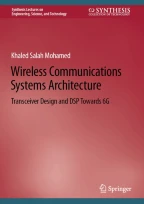Abstract
In common communication systems confidentiality are ensured exclusively by encryption of the messages. This chapter covers the security procedures in wireless communication systems. The goal of physical layer security is to make use of the properties of the physical layer to enable critical security aspects. Moreover, wireless communication services are rapidly increasing because of the proliferation of mobile devices and the advent of the Internet of Things (IoT). Authentication is an important issue in wireless communications because the open nature of the wireless medium provides more security vulnerabilities. Most of existing wireless communication systems achieve the authentication goal via upper-layer authentication mechanisms.
Access this chapter
Tax calculation will be finalised at checkout
Purchases are for personal use only
References
I. Ahmad, S. Shahabuddin, T. Kumar, J. Okwuibe, A. Gurtov, M. Ylianttila, Security for 5G and beyond. IEEE Commun. Surveys Tuts. 21(4), 3682–3722 (2019)
N. Xie, C. Chen, M. Zhong, Security model of authentication at the physical layer and performance analysis over fading channels. IEEE Trans. Depend. Secure Comput. 27 (2018)
P. Zhang, T. Taleb, X. Jiang, B. Wu, Physical layer authentication for massive MIMO systems with hardware impairments. IEEE Trans Ind. Informat. 19(3), 1563–1576 (2020)
https://www.sciencedirect.com/topics/computer-science/stream-ciphers
K.D. Deepak, D. Pawan, Performance comparison of symmetric data encryption techniques. Int. J. Adv. Res. Comput. Eng. Technol. 1(4), (2012). ISSN: 2278-1323
P. Kalpana, S. Singaraju, Data security in cloud computing using RSA algorithm. Int. J. Res. Comput. Commun. Technol. IJRCCT 1(4), 145 (2012). ISSN 2278-5841
A.H. Vinck, Introduction to Public Key Cryptography (Duisburg-Essen, Germany, 2012). Retrieved from http://www.exp-math.uni-essen.de/~vinck/crypto/script-crypto-pdf/add-to-3.pdf. 12 May 2012
J.T.J. Penttinen, 5G Explained: Security and Deployment of Advanced Mobile Communications (Wiley, 2019)
K.S. Mohamed, Cryptography concepts: integrity, authentication, availability, access control, and non-repudiation, in New Frontiers in Cryptography (Springer, Cham, 2020), pp. 41–63
B. Sun, Z. Liu, V. Rijmen, R. Li, L. Cheng, Q. Wang, H. Alkhzaimi, C. Li, Links among impossible differential, integral and zero correlation linear cryptanalysis, in Annual Cryptology Conference (Springer, 2015), pp. 95–115
S. Tajik, E. Dietz, S. Frohmann, J.-P. Seifert, D. Nedospasov, C. Helfmeier, C. Boit, H. Dittrich, Physical characterization of arbiter PUFs, in International Workshop on Cryptographic Hardware and Embedded Systems (Springer, 2014), pp. 493–509
C. Li, D. Lin, B. Feng, J. Lü, F. Hao, Cryptanalysis of a chaotic image encryption algorithm based on information entropy. IEEE Access 6, 75834–75842 (2018)
X. Chai, Z. Gan, K. Yang, Y. Chen, X. Liu, An image encryption algorithm based on the memristive hyperchaotic system, cellular automata and DNA sequence operations. Sig. Process. Image Commun. 52, 6–19 (2017)
Y. Zhang, The image encryption algorithm based on chaos and DNA computing. Multimedia Tools Appl. 77(16), 21589–21615 (2018)
Author information
Authors and Affiliations
Corresponding author
Rights and permissions
Copyright information
© 2022 The Author(s), under exclusive license to Springer Nature Switzerland AG
About this chapter
Cite this chapter
Mohamed, K.S. (2022). Wireless Communication Systems: Confidentiality. In: Wireless Communications Systems Architecture. Synthesis Lectures on Engineering, Science, and Technology. Springer, Cham. https://doi.org/10.1007/978-3-031-19297-5_3
Download citation
DOI: https://doi.org/10.1007/978-3-031-19297-5_3
Published:
Publisher Name: Springer, Cham
Print ISBN: 978-3-031-19296-8
Online ISBN: 978-3-031-19297-5
eBook Packages: Synthesis Collection of Technology (R0)eBColl Synthesis Collection 11
